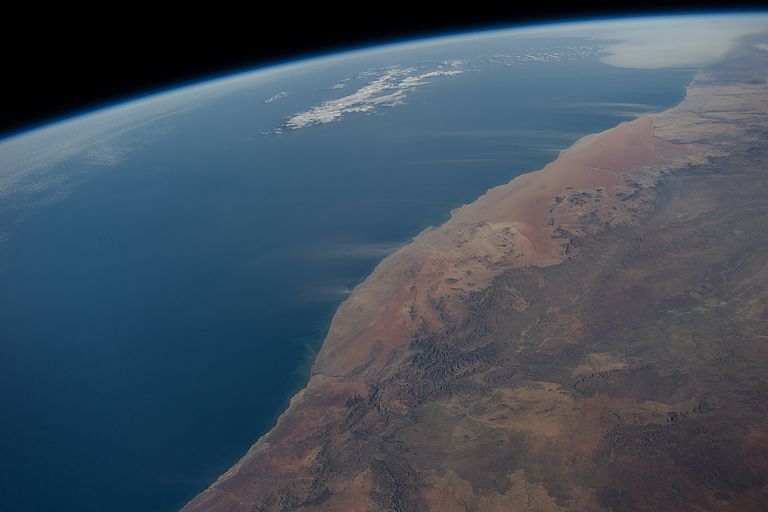“Ocean Glow” to shed new light on the controls of ocean productivity
GEOMAR scientist Dr. Thomas Browning receives ERC Starting Grant
The tiniest organisms in the ocean provide the foundation for all marine life: single-celled ocean plants, phytoplankton, produce organic matter that is responsible for powering the entire marine food web, which humans ultimately depend on. The abundance of phytoplankton can even be seen and mapped from space. However, whilst their distributions are clearly visible, it is still unclear what factors are regulating their growth and how these are being impacted by climate changes. Supported by a Starting Grant from the European Research Council (ERC) of 1.5 million euros, Dr. Thomas Browning, marine biologist and chemist at GEOMAR Helmholtz Centre for Ocean Research Kiel (Germany), aims to develop a new approach to identify which nutrients are limiting phytoplankton growth from satellite observations.
“Among the models that are currently used to predict impacts of future climate change on phytoplankton production, some show an increase and some show a decrease,” Dr. Browning explains. “As long as there is disagreement, it remains hard to assess how life-sustaining functions of the ocean, such as food provision or climate regulation, will develop in the future.”
Results from fieldwork demonstrate that ocean productivity strongly depends on the availability of nutrients, in particular nitrogen and iron. So far, observing phytoplankton nutrient limitation has required measurements made on research cruises at sea. This has restricted insights to single time point snapshots of very small parts of the ocean. Browning’s project “Ocean Glow” aims to develop an approach to take these observations to global scales using natural fluorescent light emitted from phytoplankton.
“These fluorescence signals might be telling us which nutrients are regulating phytoplankton growth, but they are currently not understood well enough to do this. Ultimately, it might be possible to undertake global monitoring using satellite observations of fluorescence, to observe climate change impacts, and to assess the accuracy of climate models”, says Dr. Browning. “Thanks to the ERC funding and building on previous work at GEOMAR, we hope to literally shed new light on crucial questions related to the impacts of climate change on the ocean.”
The ERC-funded project is planned to start in mid 2022, with a duration of five years and will involve three new postdoctoral researcher positions. A novel facility for highly-controlled experiments will be developed at GEOMAR to test the fluorescence of four, globally relevant types of phytoplankton under different nutrient conditions. Measurements from the laboratory will then be compared to data from more complex plankton communities on research expeditions. The final step will be to integrate the new information into models and analyse existing satellite data to investigate the distribution, seasonality and changes in nutrient limitation.
“If we really can decipher nutrient limitation from satellite-detected fluorescence, the impact of ‘Ocean Glow’ will be threefold”, Dr. Browning emphasises. “First, it will help to make existing Earth system models more realistic. Second, satellite data from the past 20 years can be re-analysed to document how climate change has affected ocean productivity so far. And third, we will be able to assess how widespread the different nutrient limitations in the ocean are already. This will be key to understanding future impacts of climate change on the ocean and its various functions for humankind.”
Overall, 397 early-career researchers won ERC Starting Grants with a total funding of 619 million Euros. The initial call issued under the European Union’s research and innovation programme “Horizon Europe” attracted more than 4,000 proposals, which were reviewed by renowned researchers from around the world. The selected proposals cover all disciplines of research, from medical applications of artificial intelligence to designing a legal regime for fair influencer marketing. The projects will be carried out at universities and research centres in 22 European countries, 72 of them in Germany.
About the European Research Council (ERC)
The European Research Council (ERC), set up by the European Union in 2007, is the premier European funding organisation for excellent frontier research. It funds creative researchers of any nationality and age, to run projects based across Europe. The ERC offers four core grant schemes: Starting Grants, Consolidator Grants, Advanced Grants and Synergy Grants. With its additional Proof of Concept Grant scheme, the ERC helps grantees to bridge the gap between their pioneering research and early phases of its commercialisation. The ERC is led by an independent governing body, the Scientific Council. Since 1 November 2021, Maria Leptin is the President of the ERC. The overall ERC budget from 2021 to 2027 is more than 16 billion euros, as part of the Horizon Europe programme, under the responsibility of the European Commissioner for Innovation, Research, Culture, Education and Youth, Mariya Gabriel.
![[Translate to English:] Phytoplankton](/fileadmin/_processed_/9/a/csm_Phytoplankton_AnnegretStuhr-GEOMAR_537952383e.jpg)
![[Translate to English:] Global map](/fileadmin/_processed_/3/5/csm_Phytoplanktonmap_ThomasBrowning-GEOMAR_9ee1811565.jpg)



